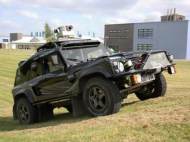Wildcat autonomous robot car doesn’t need GPS to operate
 Researchers from the University of Oxford are developing a robotic car technology which is set to remove the dependence on GPS, improve navigation precision, lower emissions, interpret local traffic conditions, track risks, and above all offer a hands-free experience to the driver. All this by interpreting a flood of data from sensors such as cameras, radars, and lasers mounted on the car itself.
Researchers from the University of Oxford are developing a robotic car technology which is set to remove the dependence on GPS, improve navigation precision, lower emissions, interpret local traffic conditions, track risks, and above all offer a hands-free experience to the driver. All this by interpreting a flood of data from sensors such as cameras, radars, and lasers mounted on the car itself.
“Only by understanding its environment can an autonomous vehicle genuinely drive itself, safely, without the need for human intervention”, said lead researcher Paul Newman, Professor at the Oxford University’s Department of Engineering Science. “Our long-term aim is to enable a new generation of robotic vehicles that can make the roads safer, less congested, cleaner, and personal transport more accessible. We do this by making smarter cars.”
Supported by the Engineering and Physical Sciences Research Council (EPSRC), the The Oxford Mobile Robotics Group researchers collaborate with BAE Systems and Nissan in order to create an autonomous vehicle that can go anywhere and deal with all the situations it might encounter on the open road.
Unlike industrial robots in factory and port facilities, useful autonomous cars cannot rely on embedded infrastructure, such as reflective beacons and guide wires to navigate, that are impractical, inconvenient and expensive to install and require modifying our roads and cities. The new technology is now installed on a Bowler Wildcat vehicle built by BAE Systems, and it is set to remove the dependence on GPS. The heart of it all is the smart and swift processing of laser and camera data gathered by the car on-board the car.
As long as people are unwilling to give up the independence cars provide, the increscent of public transport won’t be adopted as easily as expected. Experts working with the British Department for Transport believe that future autonomous vehicles will be able to make road journeys safer and more efficient.
“The good news is we are not doomed to a future of traffic congestion and accidents”, said Professor Newman. “We need cars that do the thinking and concentrating for you, cars that do not insist you do the driving all the time. If the going is slow why can’t I watch the show I missed last night, Skype with the kids, read a book or send that last email and elect the car to handle the drudgery of the trip for me?”
If you want to watch more videos about the Wildcat, visit the Oxford Mobile Group Wildcat playlist on YouTube.









Thanks for the link to other videos of the group, they explain it much better than the introductory video embedded here.